- Bernard Preston homepage
- Easy LUNCH
- Growing Lettuce
Growing lettuce
Growing lettuce is the best way to have really fresh-greens daily.
It's as easy as pudding and pie. Prepare just one yard of garden thoroughly, plant the seeds and water; wait about five-weeks and then enjoy a few leaves every day for months. Really, what could be simpler?
That's not the whole truth; you also have to weed them.
Even plant them in a small window-box but like all vegetables they do like plenty of sunshine and water.
The butterhead is my favourite but we are experimenting with many different varieties and colours. Each has its virtues and can be counted in your efforts to enjoy eight coloured foods per day; that means 35 percent less all-cause of death, remember.
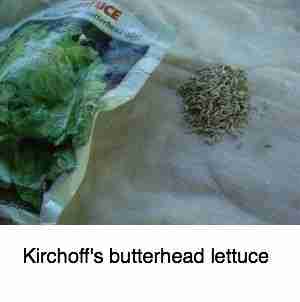
This page was last updated by Bernard Preston on 1st March, 2025.
We have just reaped our first few lettuce-leaves. It is time to plant the next row of seeds.
Growing lettuce
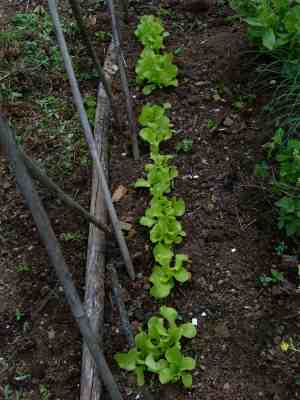
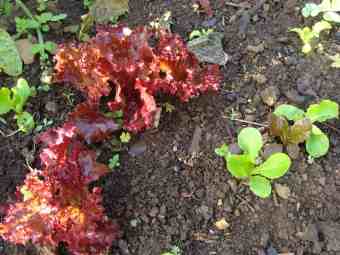
Experiment with different coloured lettuce-plants; each has its subtle virtues and adds variety to your plate of salads. The visual impact on the family is not unimportant.
We have had half a dozen varieties growing in our garden this summer but this butterhead-lettuce by Kirchoff is my favourite. There are enough seeds in the little R15 packet, one dollar to supply the local supermarket with fresh produce.
I particularly like butterhead because you can pick the leaves and the plant continues growing for months. Every day for half an hour's garden work, once-off, you have fresh lettuce on the plate. There is nothing worse than old, wilting and slimy greens.
A salad is incomplete without fresh-lettuce in my humble opinion; the proliferation of recipes boasting of no greens is because they are often awful from the supermarket. Grow your own; it's so easy.
The leaves do start to become bitter after a couple months, so successive sowings every few weeks makes a lot of sense.
Half a can in hot weather is vital; the leaves become tough if they dry out. In part, it is that water that they carry with them into your bowels that helps prevent the great misery, by the way. There are just so many benefits from fresh greens on the table every day; an easy-stool is just one of them.
Growing lettuce
Growing lettuce is one of the easiest and most rewarding salads in the garden; high-folate levels fresh on the table every day.
The seeds are very small, so you need to till the ground really thoroughly; only a yard long. This is where all that hard work with your compact compost tumbler or your own pile really comes into its own. They are heavy feeders; if you want healthy leaves for your lettuce salad recipes, make your own or buy in some well-rotted humus.
Identify a one-metre long piece of ground; that is all you need.
This is the yard I have chosen, right next to the lettuce that are now beginning to bolt (and get bitter); it's a good sunny spot.
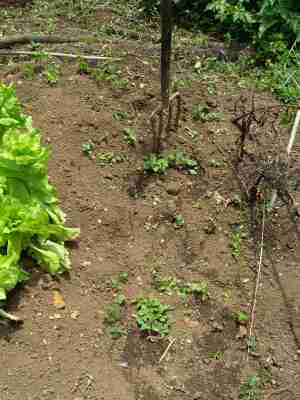
Three minutes to turn the sod with a garden fork. Wear a hat; melanomas are not friendly. Having said that, our vitamin D levels are often not adequate so we do need exposure to the sun; 15 to 30 minutes in short-sleeves and shorts is what is required. Surprisingly the ultraviolet at midday is less damaging than that early and late.
Humus for lettuces
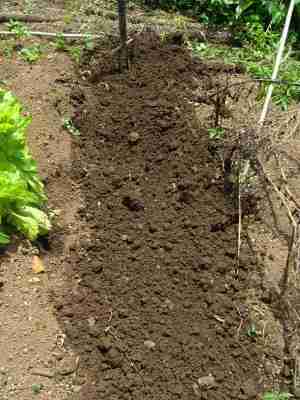
Here is my humus, work it in thoroughly. It is well-rotted as you can see; in fact good compost looks barely different to ordinary soil. A couple spadefuls is all you need.
- Starting your own compost pile is indeed hard work, unlike growing lettuce; but so rewarding.
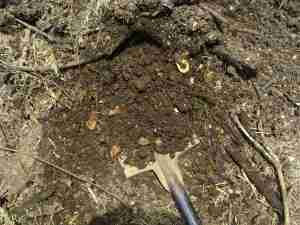
Here are two spadefuls. Now fork it in thoroughly.
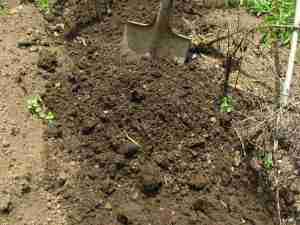
Lettuce-seeds are very tiny, so break the clods down thoroughly with the garden fork. Drill in a line about half an inch deep, sprinkle them very sparingly and cover; gently compact the soil.
A stake at each end of the row keeps yours and other big-feet at bay.
Water your lettuces regularly
Here are your lettuce seedlings two-weeks later. They will need to be watered every hot day until they are well established; and do keep the weeds at bay.
Some gardening authorities advocate transplanting the seedlings to a larger-bed. Frankly I could not be bothered. It's a lot of schlepp and moving them really sets the young plants back.
You might want to transplant out a few if you have sowed the seed too thickly. But I prefer to spread them thinly; and just set another yard-long bed in a few weeks' time.
Transplanting is hard work and it sets the plants back by two-weeks. Rather sow your seeds thinly in situ.
Chickens love lettuce
This year we have had a new troublesome development, not that we are going back; the addition of chickens to our garden has provided a wonderful supply of omega 3 rich golden-orange yolked eggs. But the birds scratch out the baby seedlings given half a chance.
We either keep them firmly in the chicken tractor, or the latest thought is to divide the garden in two with a fence; they do not seem to eat the seedlings, just scratch them out in search of worms. Once mature they take much less interest than in kale and broccoli; they particularly love the dark-green leafy veggies.
It's all about a phytonutrient called lutein that is found in dark-green veggies. A blind chicken is a dead bird. I don't want macular degeneration either; nor do you.
This page on growing lettuce was written several years ago. Since then I have been honing up my welding-skills, working on a steel gate design and putting up a vegetable garden fence; actually several. This means we now have five large runs for the hens; they can be kept out of some whilst the seedlings are at a sensitive stage. But you can never let them near kale, broccoli and spinach.
As one patch of the summer vegetable garden is used up and the produce finished, so we move the birds in to clean up what is left, fertilise the ground and scratch out the pests that are a problem in every patch of organic lettuce; if it is not cutworms, then it is grasshoppers.
Much of the bamboo below that shades this patch has been dug out too; enough remains to protect us from the beehives.
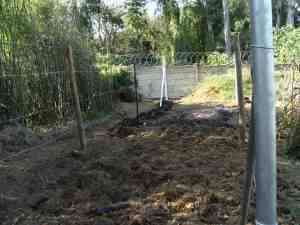
The exception is bush-beans; those they nail, after the extra protein in legumes that they need for the eggs.
So it is pole beans in the main in our garden. It is lovely to have these little challenges along the way and to share them with you; you will have your own struggles. It is all on the summer vegetable garden menu.
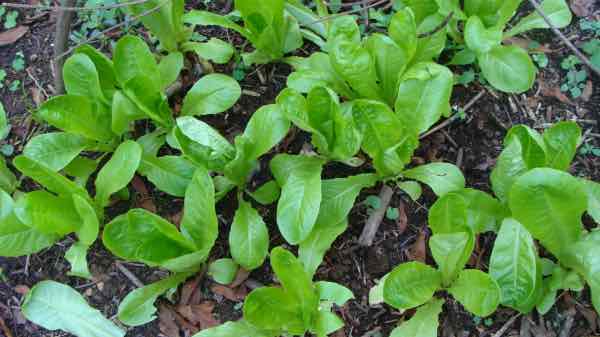
Growing lettuce is a cinch. The seedlings above are six-weeks old and we have started picking enough for a green salad every day; and will continue to do so for at least two months. Water them frequently, even daily.
Fresh, crisp-lettuce is the order of every day. They do prefer the cooler weather; when it gets hot they will bolt.
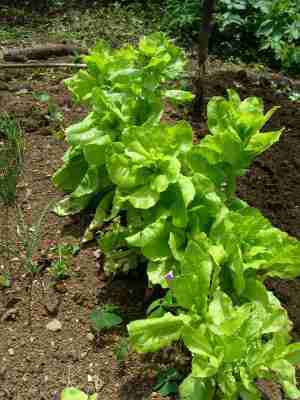
These are the plants I sowed three months ago. They are bolting as you can see but we have had fresh lettuce every day from this one-yard row.
High folate levels
High folate levels will improve your children's school performance; growing lettuce is the way to start.
Growing lettuce has innumerable benefits, not least that, when your friends and family cease to satisfy, there is always an escape to the garden in the offing; or a good-book by Bernard Preston.
Nutritionally lettuce is loaded with a very important vitamin called folate.
High folate levels are particularly important for nerves, brain and spinal-cord development. Children deficient in vitamin B9, perform poorly in school, for example.
Newsletter
Our newsletter is entitled "create a cyan zone" at your home, preserving both yourself and Mother Earth for future generations; and the family too, of course. We promise not to spam you with daily emails promoting various products. You may get an occasional nudge to buy one of my books.
Here are the back issues.
- Lifestyle and ideal body weight
- What are ultra-processed foods?
- Investing in long-term health
- Diseases from plastic exposure
- Intensive lifestyle management for obesity has limited value
- A world largely devoid of Parkinson's Disease
- The impact of friendly bacteria in the tum on the prevention of cancer
- There's a hole in the bucket
- Everyone is talking about weight loss drugs
- Pull the sweet tooth
- If you suffer from heartburn plant a susu
- Refined maize meal and stunting
- Should agriculture and industry get priority for water and electricity?
- Nature is calling
- Mill your own flour
- Bake your own sourdough bread
- Microplastics from our water
- Alternative types of water storage
- Wear your clothes out
- Comfort foods
- Create a bee-friendly environment
- Go to bed slightly hungry
- Keep bees
- Blue zone folk are religious
- Reduce plastic waste
- Family is important
- What can go in compost?
- Grow broad beans for longevity
- Harvest and store sunshine
- Blue zone exercise
- Harvest and store your rainwater
- Create a cyan zone at your home
Hence my interest in growing lettuce, firstly as a grandparent and secondly as a DC. I have had patients with spinal-bifida and it is not pretty; and entirely preventable with fresh greens every day. I make sure they are there for the family every lunch, especially for the little people.
Freshly squeezed orange juice is another great source of folate; spina bifida is heart-breaking.
Lettuce is also one of the rich phytochemical foods by the way. Absolutely eat a minimum of five coloured-fruit and veg per day and aim for ten; if you do not want to get the big C that is. Just a snippet of parsley would count.
Chicken tractor design
This chicken tractor design is worthy of consideration by every organic gardener with something rather larger than a postage stamp. Moving the chooks from the tired looking lettuce patch to the corn stalks and on to the remains of the Swiss chard is what keeps them excited and healthy; whilst enriching your plot of ground with nitrogen-rich fertiliser.
Chicken tractor designs come in many shapes and sizes; do your homework before choosing or making one. Your growing lettuce will thrive on the extra nutrients.
Lettuce cage
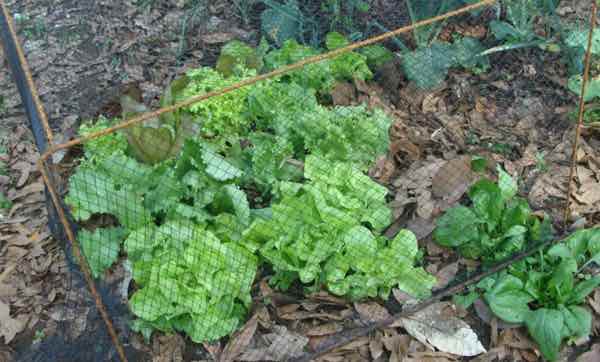
Perhaps you have a problem, as did Mr McGregor with Peter Rabbit, or as we do with Henny-Penny. The lettuce cage is the solution if you want to preserve your growing plants.
Using 5mm steel bar, bent and welded into a roughly one square metre cage. Covered with bird mesh it is easily moved, being very light; from one lettuce patch to another.
We started by using plastic netting but it stretches and is not satisfactory. I'm changing them all over to wire-mesh.
If you do not have an inverter welders, get one; and the auto-darkening helmet. It is so easy to use and a very important tool for every homeowner and gardener. I play with mine weekly for this or that; yesterday it was for a new gate.
Chickens in the garden are a pest at times; they would devour this lettuce patch in seconds but we let them in once the plants are starting to bolt. Now we have a fraction of the problems with the other creepy-crawlies that used to mark our veggies.
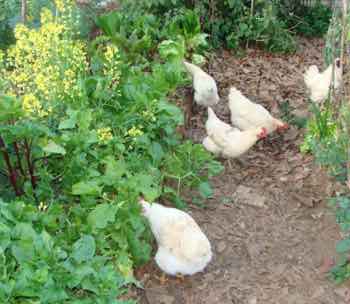
Supplementary income?
Are you bored with retirement? Do you need a supplementary-income? Growing lettuce may be a solution.
In a few weeks, when we have an abundance, I will show you how you could grow lettuce, radish and spinach; and make a healthy little business. Your local supermarket is more than likely desperate for very fresh salads. You can profit.
To do this you will need a large-garden, of course because you must rotate your plantings. You cannot grow lettuce in the same bed every year.
You will need about ten three-metre beds. Sow your seeds in one row every week. In a month you will have a enough lettuce to provide a modest supply to the local store. Pluck off the largest ravishing looking leaves every morning, wash thoroughly and put them into a sealed bag.
Better still, plant three different kinds. A clean, washed bag of varied lettuce leaves is what every busy woman is looking for when on a quick shop. Make them look attractive.
When the plants age pull them out, dump them on the compost pile and sow radish seeds.
How to grow radishes is the very easiest of them all.
Why is growing lettuces on a Bernard Preston website?
Bernard-Preston.com is all about simple, easy and resilient living. Whilst my three books are tales taken from the coalface of a DC, funny, sometimes tragic, delightful stories, the underlying theme is let us move up to that higher place where we have more energy from our nutritious food; and less time spent on umpteen visits to doctors of various ilks.
Lettuce wraps recipes
Lettuce wraps recipes are just one way to enjoy your organic green foods.
Because the folate in our greens is so vital for school achievement we look for different ways to encourage our grandchildren to enjoy more salads; lettuce wraps recipes for the lunch-box is just one of them.
Whether growing lettuce or purchased from the green grocer, they give vital nutrients to us all.
Lettuce salad recipes
Lettuce forms the basis of most green salads and for good reasons; it is inexpensive, simple to grow and provides many vital nutrients.
Only it is really difficult to get them freshly-picked from the shop. Grow your own lettuce.
Cancer specialists are recommending that for prevention we need to eat a whole grain and a legume at every meal. Hardly anyone does that; but this authentic hummus recipe makes every lettuce salad a winner.
Hummus is rich in lemon juice and olive oil; and the chickpeas are the top source of vitamin B6 without which we cannot enjoy optimal wellness. There's no reason not to mix a scoop into your beef stew for supper.
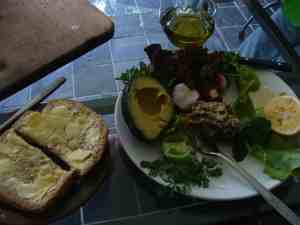
Kaempferol and tumour prevention
Bernard Preston comes from a vegetarian family but also loves meat; he tries to combine both worlds in a nutritious and healthy way. Growing lettuce is just one aspect of making sure there are high folate levels in the family; sharing a home with the next generation so that they too will be passionate about the benefits of fresh, organic salads.
Malignancies seems to strike all around us, so kaempferol and tumour prevention is high on the agenda; it is one of the vital bioflavonoids found is large amounts in lettuce.
And when it comes to nasty bugs like the coronavirus, all you can do is support your immune system in the best way you possibly can; and keep your blood-glucose low. That means avoiding refined starches.
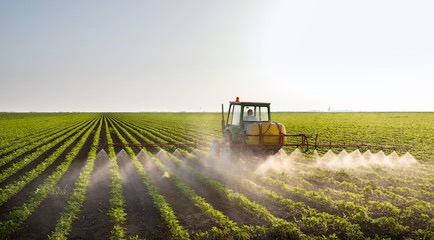
These are not the vegetables that I want to eat. How about you? Growing lettuces and as much of my food as possible is my goal.
- Spanish study of vitamins B6, C and E; and folate
- Organic Food Green
- The wonder of worm farms for liquid-fertiliser for your lettuce.
When browsing use right click and "Open Link in New Tab" or you may get a bad gateway signal.
Did you find this page interesting? How about forwarding it to a friendly book or food junkie? Better still, a social media tick would help.
- Bernard Preston homepage
- Easy LUNCH
- Growing Lettuce
Address:
56 Groenekloof Rd,
Hilton, KZN
South Africa
Website:
https://www.bernard-preston.com